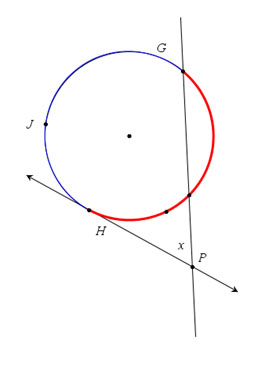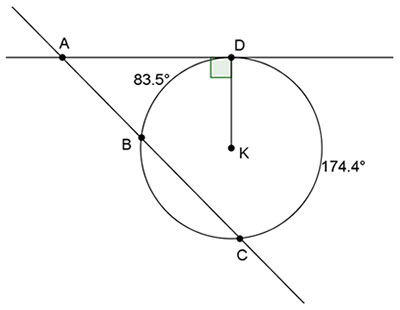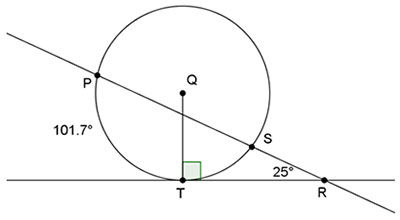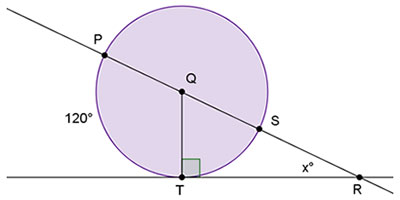
Finally, the last relationship you will explore is found when tangents and secants of a circle intersect outside of the circle. Once again, using your knowledge of intersecting lines both inside and outside of a circle, write out a hypothesis for the relationship between the angle formed by the intersection of a tangent and a secant line and the measures of the intersect arcs. Write this hypothesis in your notes.

Using the Intersecting Secant and Tangent applet linked below, click and drag the endpoints of AC so that you always have the red and blue arcs in opposite places on the circle. To change the size of your circle, click and drag point A or point E. Observe the changes in m∠D as you change the arc measurements.

![]() Click on the image below to open the applet. Manipulate the angle so that m
Click on the image below to open the applet. Manipulate the angle so that m
 AC is 110 degrees, then 130 degrees, and finally 170 degrees.
AC is 110 degrees, then 130 degrees, and finally 170 degrees.
Copy the table below into your notes. Then use the measures of the arcs to complete the table, and answer the questions below.
| m ∠ D | m
 AC AC |
m
 AB AB |
m
 AC – m AC – m
 AB AB |
| 110° | |||
| 130° | |||
| 170° |
 AC – m
AC – m
 AB?
AB?
Interactive popup. Assistance may be required.
m ∠D = 1 over 2 1 2 (m AC – m
AC – m
 AB)
AB)

 AC and
AC and
 AB are the intercepted arcs of the tangent and secant, what can you say about the measure of ∠D and the measures of
AB are the intercepted arcs of the tangent and secant, what can you say about the measure of ∠D and the measures of
 AC and
AC and
 AB?
AB?
Interactive popup. Assistance may be required.
If a tangent and a secant intersect at a common point, then the measure of the angle formed is equal to half the difference of the measures of the intercepted arcs.
How does the relationship that you discovered for a tangent and a secant that intersect outside a circle compare to the relationships you discovered for two intersecting tangents and two secants that intersect outside a circle?

Interactive popup. Assistance may be required.
The measure of the angle between an intersecting tangent and secant is one-half the difference of the measures of the intercepted arcs.
Interactive popup. Assistance may be required.
m∠DAC = 1 over 2 1 2 (m CD – m
CD – m
 BD)
BD)
 ST?
ST?

Interactive popup. Assistance may be required.
The measure of the angle between an intersecting tangent and secant is one-half the difference of the measures of the intercepted arcs.
Interactive popup. Assistance may be required.
m∠SRT = 1 over 2 1 2 (m PT – m
PT – m
 ST)
ST) ST)
ST) ST
ST ST = 50.85° – 25°
ST = 50.85° – 25° ST = 51.7°
ST = 51.7°

 RP, that m
RP, that m
 PT along the backside of the building will be 120°. What is the angle between the observer’s line of sight toward the center of the building and a tangent line toward the edge of the building?
PT along the backside of the building will be 120°. What is the angle between the observer’s line of sight toward the center of the building and a tangent line toward the edge of the building?

Interactive popup. Assistance may be required.
The measure of the angle between an intersecting tangent and secant is one-half the difference of the measures of the intercepted arcs.
Interactive popup. Assistance may be required.
m∠SRT = 1 over 2 1 2 (m PT – m
PT – m
 ST)
ST) ST.
ST. PT + m
PT + m
 ST = 180°
ST = 180° ST = 180°
ST = 180° ST = 60°
ST = 60° PT – m
PT – m
 ST)
ST)
